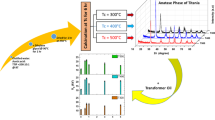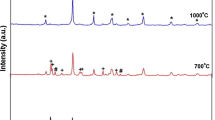Abstract
In the current paper, hematite (α Fe2O3) nanoparticles (NPs) were prepared by the chemical co-precipitation method. These synthesized nanoparticles were characterized by X-ray diffraction (XRD), scanning electron microscopy (SEM), Fourier transform infrared (FTIR), Raman spectroscopy, and vibrating sample magnetometry (VSM). The XRD studies for the nanoparticles revealed rhombohedral symmetry with space group: R3c (167), and the particle size is about 33.34 nm. The morphological studies carried out by SEM indicated that these prepared samples have a spherical morphology with some porosity. The specific surface area of this sample was calculated by the Brunauer–Emmett–Teller (BET) technique. FTIR spectroscopy confirms the Fe–O and O–Fe–O vibrations corresponding to stretching at the expected positions (520 cm−1) related to the structure. From Raman data, modes corresponding to α-Fe2O3 are seen. From DC magnetisation studies, the current sample shows ferrimagnetic behavior. In addition, the value of Ms is 1.027 and value of Mr is 322.787×10–6. Further nanofluids of these nanoparticles with different concentrations of transformer oil were prepared. The performance of this nanofluid as a coolant in transformer oil was also studied. The 0.2 g/l concentration shows the maximum improvement in breakdown voltage. Hence, under optimal conditions, these ferrofluids can perform well for insulating purposes.









Similar content being viewed by others
Data availability
The data of this manuscript will be available on request.
References
Akbar S, Hasanain SK, Azmat N, Nadeem M (2004) Synthesis of Fe2O3 nanoparticles by new Sol-Gel method and their structural and magnetic characterizations. arXiv preprint cond-mat/0408480.
Ali A, Zafar H, Zia M, Ul Haq I, Phull AR, Ali JS, Hussain A (2016) Synthesis, characterization, applications, and challenges of iron oxide nanoparticles. Nanotechnol Sci Appl. https://doi.org/10.2147/NSA.S99986
Ayachi AA, Mechakra H, Silvan MM, Boudjaadar S, Achour S (2015) Monodisperse α-Fe2O3 nanoplatelets: synthesis and characterization. Ceram Int 41(2):2228–2233
Basavaraja S, Balaji DS, Bedre MD, Raghunandan D, PrithvirajSwamy PM, Venkataraman A (2011) Solvothermal synthesis and characterization of acicular α-Fe 2 O 3 nanoparticles. Bull Mater Sci 34:1313–1317
Bashtovoy V, Berkovsky BM (1996) Magnetic fluids and applications handbook. Begell House Publishers Inc., U.S. https://doi.org/10.1615/978-1-56700-062-7.0
Bersani D, Lottici PP, Montenero A (1999) Micro-Raman investigation of iron oxide films and powders produced by sol–gel syntheses. J Raman Spectrosc 30(5):355–360
Carmona-Carmona AJ, Palomino-Ovando MA, Hernández-Cristobal O, Sánchez-Mora E, Toledo-Solano M (2017) Synthesis and characterization of magnetic opal/Fe3O4 colloidal crystal. J Cryst Growth 462:6–11
Chaki SH, Malek TJ, Chaudhary MD, Tailor JP, Deshpande MP (2015) Magnetite Fe3O4 nanoparticles synthesis by wet chemical reduction and their characterization. Adv Nat Sci Nanosci Nanotechnol 6(3):035009
Choi SU, Eastman JA (1995) Enhancing thermal conductivity of fluids with nanoparticles (No. ANL/MSD/CP-84938; CONF-951135–29). Argonne National Lab.(ANL), Argonne, IL (United States)
Dash P, Yang JM, Lin H, Lin AS (2020) Preparation and characterization of zinc gallate phosphor for electrochemical luminescence. J Lumin 228:117593
de Faria DLA, Lopes FN (2007) Heated goethite and natural hematite: Can Raman spectroscopy be used to differentiate them? Vib Spectrosc 45(2):117–121
Du BX, Li XL (2017) Dielectric and thermal characteristics of vegetable oil filled with BN nanoparticles. IEEE Trans Dielectr Electr Insul 24(2):956–963
El-Maghrabi HH, Al-Kahlawy AA, Nada AA, Zaki T (2018) Photocorrosion resistant Ag2CO3@ Fe2O3/TiO2-NT nanocomposite for efficient visible light photocatalytic degradation activities. J Hazard Mater 360:250–256
Elshypany R, Selim H, Zakaria K, Moustafa AH, Sadeek SA, Sharaa SI, Nada AA (2021) Elaboration of Fe3O4/ZnO nanocomposite with highly performance photocatalytic activity for degradation methylene blue under visible light irradiation. Environ Technol Innov 23:101710
Fernández I, Valiente R, Ortiz F, Renedo CJ, Ortiz A (2020) Effect of TiO2 and zno nanoparticles on the performance of dielectric nanofluids based on vegetable esters during their aging. Nanomaterials 10(4):692
Hamed Mashhadzadeh A, Ghanbari M, Koochaki A, Seyyedbarzegar S, GhorbanzadehAhangari M (2023) Partial discharge elimination in transformer oils by nanofluids: from theory to practice. Arab J Sci Eng 48(5):6253–6270
Hasan MI (2017) Improving the cooling performance of electrical distribution transformer using transformer oil-based MEPCM suspension. Eng Sci Technol Int J 20(2):502–510
Hebner RE (1988) Measurement of electrical breakdown in liquids. The liquid state and its electrical properties. Springer, US, Boston, MA, pp 519–537
Hussain MR, Khan Q, Khan AA, Refaat SS, Abu-Rub H (2020) Dielectric performance of magneto-nanofluids for advancing oil-immersed power transformer. IEEE Access 8:163316–163328
Hussain M, Mir FA, Ansari MA (2022) Nanofluid transformer oil for cooling and insulating applications: a brief review. Appl Surf Sci Adv 8:100223
Ibrahim ME, Abd-Elhady AM, Izzularab MA (2016) Effect of nanoparticles on transformer oil breakdown strength: experiment and theory. IET Sci Meas Technol 10(8):839–845
IEC (1995) 60156 insulating liquids determination of breakdown voltage at power frequency test method International standard second edition 1995–07
Kayani ZN, Arshad S, Riaz S, Naseem S (2014) Synthesis of iron oxide nanoparticles by sol–gel technique and their characterization. IEEE Trans Magn 50(8):1–4
Khot VM, Salunkhe AB, Thorat ND, Phadatare MR, Pawar SH (2013) Induction heating studies of combustion synthesized MgFe2O4 nanoparticles for hyperthermia applications. J Magn Magn Mater 332:48–51
Lau KY, Vaughan AS, Chen G (2015) Nanodielectrics: opportunities and challenges. IEEE Electr Insul Mag 31(4):45–54
Lee JC, Kim WY (2012) Experimental study on the dielectric breakdown voltage of the insulating oil mixed with magnetic nanoparticles. Phys Procedia 32:327–334
León CP, Kador L, Zhang M, Müller AH (2004) In situ laser-induced formation of α-Fe2O3 from Fe3+ ions in a cylindrical core-shell polymer brush. J Raman Spectrosc 35(2):165–169
Lv Y, Rafiq M, Li C, Shan B (2017) Study of dielectric breakdown performance of transformer oil based magnetic nanofluids. Energies 10(7):1025
Ma Y, Xie XY, Chen HY, Zhang TH, Debela TT (2021) The growth mode of α-Fe2O3 thin films by DC magnetron sputtering. Vacuum 194:110625
Mansour H, Letifi H, Bargougui R, De Almeida-Didry S, Negulescu B, Autret-Lambert C, Ammar S (2017) Structural, optical, magnetic and electrical properties of hematite (α-Fe 2 O 3) nanoparticles synthesized by two methods: polyol and precipitation. Appl Phys A 123:1–10
Maryline N, Roman V, Philippe M, Stéphanie R Mikhael B (2017) Mesoporous ZnFe2O4@ TiO2 nanofibers prepared by electrospinning coupled to PECVD as highly performing photocatalytic materials
Mashhadzadeh AH, Seyyedbarzegar SM, Samani A (2023) Experimental analysis and physical mechanism investigation of Al2O3 effect on new and aged transformer oil properties. Int J Eng 36(3):548–557
Mirzaei A, Janghorban K, Hashemi B, Hosseini SR, Bonyani M, Leonardi SG, Neri G (2016) Synthesis and characterization of mesoporous α-Fe2O3 nanoparticles and investigation of electrical properties of fabricated thick films. Process Appl Ceram 10(4):209–217
Nsofor EC (2008) Recent patents on nanofluids (nanoparticles in liquids) heat transfer. Recent Pat Mech Eng 1(3):190–197
Olmo Salas C, Méndez Gutiérrez C, Quintanilla Cavia PJ, Ortiz Fernández F, Renedo Estébanez CJ, Ortiz Fernández A (2022) Mineral and ester nanofluids as dielectric cooling liquid for power transformers. Nanomaterials 12(15):2723
Panda PK, Sadeghi K, Park K, Seo J (2022) Regeneration approach to enhance the antimicrobial and antioxidant activities of chitosan for biomedical applications. Polymers 15(1):132
Perigo EA, Hemery G, Sandre O, Ortega D, Garaio E, Plazaola F, Teran FJ (2015) Fundamentals and advances in magnetic hyperthermia. Appl Phys Rev. https://doi.org/10.1063/1.4935688
Rafiq M, Li C, Lv Y, Yi K, Sun Q (2016a) Breakdown characteristics of mineral oil based magnetic nanofluids. In: 2016 IEEE international conference on high voltage engineering and application (ICHVE). IEEE. pp 1–4
Rafiq M, Li C, Ge Y, Lv Y, Yi K (2016b) Effect of Fe 3 O 4 nanoparticle concentrations on dielectric property of transformer oil. In: 2016 IEEE international conference on high voltage engineering and application (ICHVE). IEEE. pp. 1–4
Rasheed RT, Al-Algawi SD, Kareem HH, Mansoor HS (2018) Preparation and characterization of hematite iron oxide (α-Fe2O3) by sol-gel method. Chem Sci J 9(197):2
Shariatzadeh SMR, Salimi M, Fathinejad H, HassaniJoshaghani A (2022) Nanostructured α-Fe2O3: solvothermal synthesis, characterization, and effect of synthesis parameters on structural properties. Int J Eng 35(6):1186–1192
Sima WX, Cao XF, Yang Q, Song H, Shi J (2014) Preparation of three transformer oil-based nanofluids and comparison of their impulse breakdown characteristics. Nanosci Nanotechnol Lett 6(3):250–256
Sulemani MS, Majid A, Khan F, Ahmad N, Abid M. A, Khan IU (2018) Effect of nanoparticles on breakdown, aging and other properties of vegetable oil. In 2018 1st international conference on power, energy and smart grid (ICPESG). IEEE. pp. 1–6
Wang Q, Rafiq M, Lv Y, Li C, Yi K (2016) Preparation of three types of transformer oil-based nanofluids and comparative study on the effect of nanoparticle concentrations on insulating property of transformer oil. J Nanotechol. https://doi.org/10.1155/2016/5802753
Yasmin H, Giwa SO, Noor S, Sharifpur M (2023a) Experimental exploration of hybrid nanofluids as energy-efficient fluids in solar and thermal energy storage applications. Nanomaterials 13(2):278
Yasmin H, Giwa SO, Noor S, Aybar HS (2023b) Reproduction of nanofluid synthesis, thermal properties and experiments in engineering: a research paradigm shift. Energies 2023(16):1145
Acknowledgements
One of the authors FAM is highly thankful to the UGC, New Delhi UGC for the start-up grant. MH would also thank MHRD India for the TEQIP-III grant.
Author information
Authors and Affiliations
Corresponding author
Ethics declarations
Competing interests
We don’t have any competing interests related to this paper.
Additional information
Publisher's Note
Springer Nature remains neutral with regard to jurisdictional claims in published maps and institutional affiliations.
Rights and permissions
Springer Nature or its licensor (e.g. a society or other partner) holds exclusive rights to this article under a publishing agreement with the author(s) or other rightsholder(s); author self-archiving of the accepted manuscript version of this article is solely governed by the terms of such publishing agreement and applicable law.
About this article
Cite this article
Hussain, M., Ansari, M.A. & Mir, F.A. Effect of α-Fe2O3 on transformer cooling and application. Appl Nanosci 14, 753–760 (2024). https://doi.org/10.1007/s13204-024-03040-3
Received:
Accepted:
Published:
Issue Date:
DOI: https://doi.org/10.1007/s13204-024-03040-3




